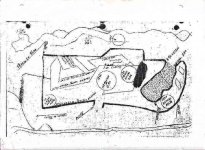sdcfia
Silver Member
- Sep 28, 2014
- 3,661
- 8,888
- Primary Interest:
- Other
I note with interest the name "Starr" in the lower right hand corner of that map showing zig-zag levels of ladders descending....
Many of our "treasure legends" are well known in the media but are sorely lacking in verifiable evidence - and I don't mean hearsay, newspaper stories and family traditions. I guess that's why they're still legends and not acknowledged facts. Names are important when it comes to all these mystifying legends, especially peoples' names (real or assumed), and place names. It would be interesting to know why Noss chose "Starr" as his alter ego, since that name in OK is linked with numerous other outlaw treasure legends, either directly or by association. Huh ... maybe just a coincidence.


 ).
).



